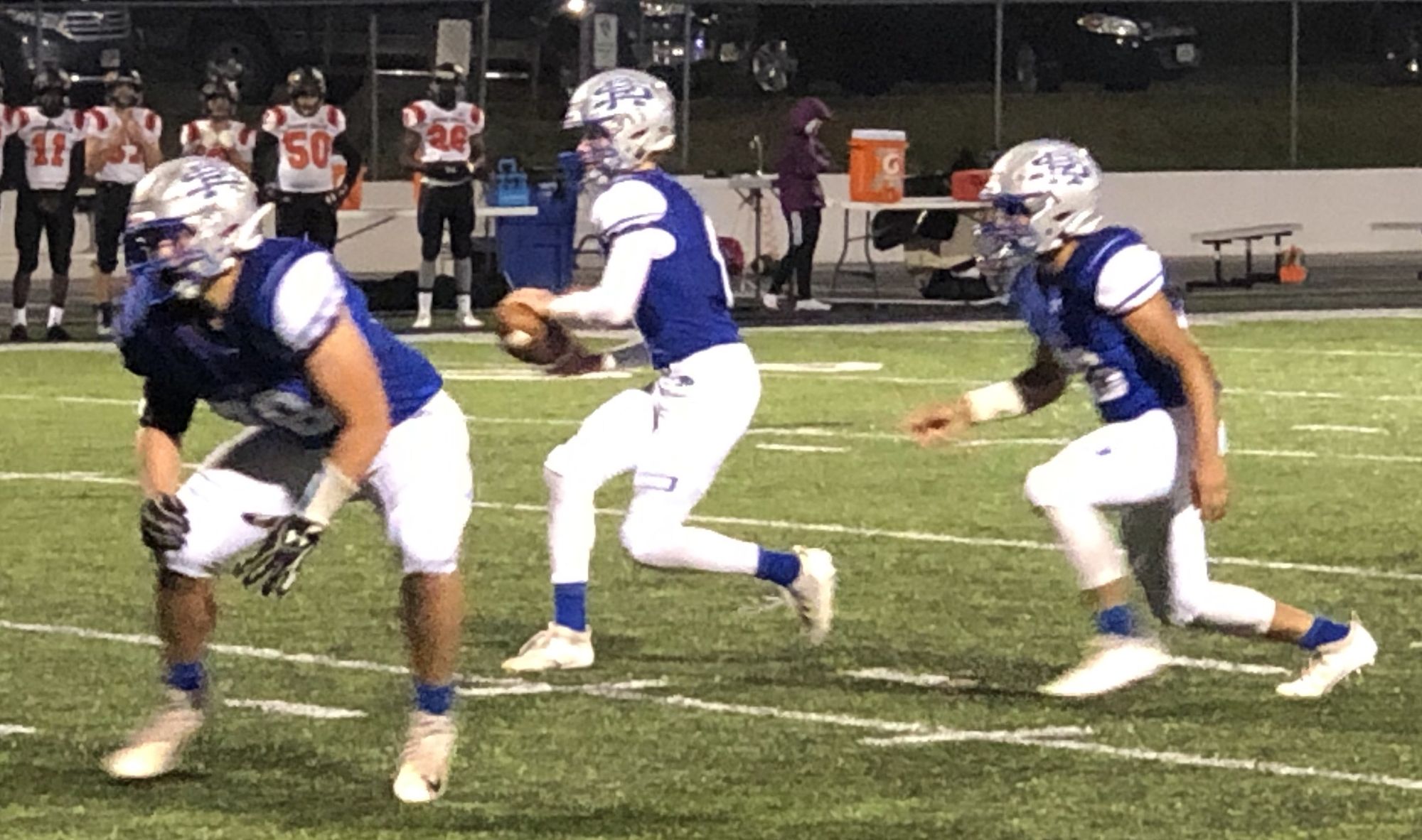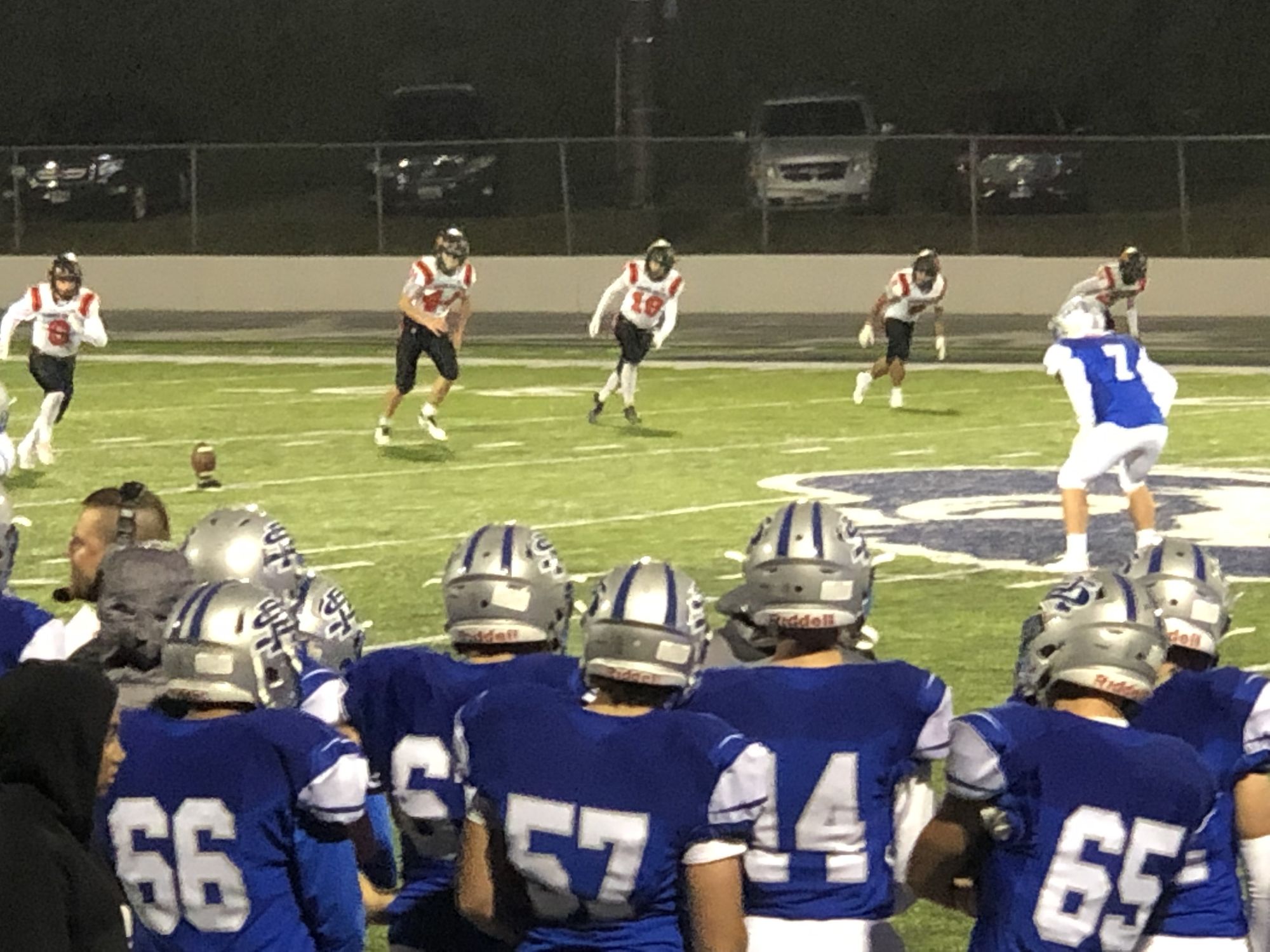Tackle football remains one of the most popular sports in America, but participation in high school football in South Dakota and across the United States is falling steadily as the risk of brain injuries from the sport becomes clearer.
Participation in 11-player boys football in South Dakota fell by 5.2% over the past three years, and dropped by 16.6% over the past decade, according to data from the National Federation of State High School Associations, which has done annual participation surveys for more than 25 years.
Participation in nine-player football, played in smaller, mostly rural districts, fell by 3.7% across the nation over the past 10 years, according to the survey.
The decreases came as student enrollment in grades nine through 12 in South Dakota — the grades that play high school football — was essentially flat during that 10-year time frame at about 43,000 students.
Nationally, total participation in athletics fell across all sports for the first time in nearly 30 years; participation in boys 11-player high school football — the sport with the highest participation among all sports — fell by 5.2% last year to about 1.1 million players.
Recent studies have shown that from 5% to 10% of youth football players will suffer a concussion — defined as a “mild traumatic brain injury” — at some point during a full season. With about 1 million athletes playing high school football in the U.S. annually, that means between 50,000 and 100,000 teens will suffer a concussion each year, not including those at the youth and junior high levels.
Supporters of football — including players, parents, coaches and association officials — see the sport as one that builds character, focuses on teamwork and is outright fun to play and watch. They also note that fear of injury is only one element of a complex decision that high school athletes make in terms of whether to play football or any sport.
Furthermore, in South Dakota specifically, population trends have shown reduced enrollment in many rural schools and decreased opportunities for play.
“I think it’s more than just looking at the number and saying, ‘Well, over this period of time we’re down all these kids participating and that it’s because we’re concerned about safety,’” said John Krogstrand, assistant director of the South Dakota High School Activities Association, who oversees boys sports for the group. “I think it’s much more than that.”
South Dakota had 3,756 participants in 11-player boys football in 68 schools in 2009 and only 3,133 in 66 schools last year, according to the national survey. For comparison, the state had 3,576 participants in boys basketball last year, and 697 in boys soccer.
Krogstrand noted that his association and all school districts across the state have implemented new safety guidelines, improved equipment and instituted concussion protocols to prevent head injuries and treat them better when they do occur. He also said some of the drop in participation is likely due to a drop-off of high school enrollment in the early 2000s, which led some schools to end their programs.
He noted as well that much of the enrollment growth in the state has been in Sioux Falls and its suburbs, where opportunities to play are limited to one team at each school no matter how big the school gets.
But with mounting evidence of significant long-term impacts of football-related injuries, particularly those to the head and brain, the survey data reveal that parents and young players themselves are increasingly staying away from the sport.
In South Dakota, the reduction in participation has led some districts, including many in rural areas, to keep the sport alive by entering into co-op agreements in which nearby schools combine players to form a single team. Other schools that have seen enrollment and participation decreases have moved from 11-player to nine-player football, which makes it easier to field a team.
Most parents whose children play football are aware of the risks, yet many say they believe the game has gotten safer as the awareness of concussions and other head injuries has risen.

Dale Uttecht of Sioux Falls traveled to Rapid City on a recent Friday night to watch his son, Joe, play football for Sioux Falls Washington against Rapid City Stevens. As he bought four cups of hot chocolate on a rainy September night, Uttecht said he sometimes holds his breath while watching games played by Joe or his older brother Logan, who plays wide receiver for Augustana University.
“All the players are bigger, faster and stronger, so any injuries are going to be worse,” he said.
Uttecht said the increased recognition of the risks of head injuries in football has led to changes that he believes have made the game safer, including at Washington High, where a certified trainer is present for all practices and games.
“You always have concerns, but I hear about concussions in soccer and basketball, too,” Uttecht said. “It’s really their decision if they want to play to not.”
Strong link between concussions and football
Numerous research studies have shown a strong correlation between concussions and contact sports, particularly football. A concussion is a mild traumatic brain injury in which the head and brain shake violently, often causing confusion, headaches, dizziness, nausea or vomiting, and in severe cases, loss of consciousness. Most people who suffer a concussion recover fully with time, and research is inconclusive whether a single concussion will lead to long-term brain impairment. Evidence shows, however, that the longer a person plays football and the more hits to the head they take, the chance for long-range impairment or illnesses increases.
American football at the youth, high school, collegiate and professional levels has been the most-analyzed sport in relation to concussions.
The federal Centers for Disease Control and Prevention estimates that between 1.6 and 3.8 million concussions occur annually in the U.S. owing to sports and recreational activities, though many more likely go unreported and untreated.
Recent research has shown that football, hockey and rugby are the sports most likely to lead to concussions, and that 9.6% of all injuries in youth football are concussions, 4% of injuries in high school football are concussions and 8% of collegiate football injuries are concussions.
In their literature on concussions and sports, doctors at the Sanford Health Orthopedics & Sports Medicine Department in Sioux Falls write that, “One of the worst things any athlete can do for their health is to keep playing after a concussion.”
Yet those same physicians report that as many as 40% of youth athletes who suffer a concussion return to play sooner than safety guidelines suggest. They also point to research showing that athletes who suffer one concussion are more likely to have subsequent concussions and can face “potentially catastrophic consequences” if a second concussion occurs.
Children and teens are more susceptible to concussions and take longer to recover than adults, the Sanford doctors said.

Thayne Munce, associate director of the Sanford Sports Science Institute, is an expert on brain injuries related to football and has led research efforts into on-field head injuries, specifically at the middle-school level.
Munce used sensors in the helmets of seventh and eighth grade football players to measure the number and severity of hits to the head during games. Generally, his research showed that players in those grades received fewer head impacts than high school players, mainly due to fewer practices and games being held. But he also found that the severity of head impacts in the lower grades was equal to those suffered at the high school level.
“Their head-impact severity, basically what happens to a head after an impact, is nearly identical to high school level,” Munce said. “Even though they’re smaller athletes and not running as fast, their impact severity is just as high.”
Munce pointed out that significant research does not seem to show that athletes who only play through high school will have long-range brain injuries or neurological implications.
“There isn’t enough strong evidence that suggests playing youth football or through the high school level has a significant risk of long-term negative brain health consequence,” Munce said.
In a larger sense, Munce said research into football-related brain injuries is advancing rapidly, but he noted that in many ways scientists “are flying blind” when it comes to fully understanding the risks associated with the sport and its impact on the brain and long-term brain function.
A growing concern for athletes in contact sports, particularly football, is the finding that chronic traumatic encephalopathy, or CTE, has been diagnosed in people who have had repeated jolts or hits to the head, including but not limited to repeated concussions.
CTE has no treatment or cure and can lead to mood disorders, memory loss, behavior problems and dramatic personality changes. In CTE, a destructive protein spreads through the brain, killing brain cells along the way.
Some recent CTE research and individual cases have raised concerns over the potential for brain damage in football players. CTE can only be diagnosed in the brain by autopsy following death.
The results of a 2017 study by researchers at Boston University and reported in the Journal of the American Medical Association showed that CTE was found in the brains of 177 of 202 former football players, including 99% of those who played professionally and had been in the game the longest.
Study conclusions were limited, however, because of “selection bias” since the donated brains tended to come from patients who exhibited symptoms of cognition or behavioral problems before death.
New research at BU in 2018 further heightened concerns about repeated brain injuries and the connection to a condition called Lewy body disease, which can increase the risk of dementia, Parkinson’s disease and Alzheimer’s disease. The study showed that participants in contact sports including football, hockey and boxing were more likely to develop Lewy body disease, even independently of symptoms of CTE.
CTE risks drew national attention after Aaron Hernandez, a college and professional football star, committed suicide in 2017 while incarcerated on multiple murder convictions at the age of 27. Doctors later said his brain showed the worst case of CTE they had ever seen in someone so young.
The NFL has made concussion identification and prevention a top priority over the past few years, expanding examinations and increasing the list of symptoms that can prevent a player from returning to a game.
Yet Brett Favre, a retired quarterback now in the NFL Hall of Fame, has said he would not encourage his own children to play the game he loves so deeply. (Favre has said that, luckily, he has only daughters.)
The South Dakota High School Activities Association has links to information about both concussions and CTE on its website under a “Health & Safety Issues” heading, including a sample Return to Competition form that outlines protocol for safely returning athletes back to competition after suffering concussion symptoms. The form concludes with the advice, “When in doubt, sit them out.”
Krogstrand noted that his association and school districts across the state have been extremely aggressive and hands-on in improving safety for football players and improving protocols to address injuries when they do occur.
Coaches, athletic directors and referees are required to complete an annual online course about concussion prevention, identification and treatment (players with concussions must have physician approval before returning to plays, for example). Other new rules limit the time and amount of contact players can have in practices, he said.
“We’re doing everything we can with the information when we get it to minimize risk for student athletes and make it as safe as we can with the knowledge that there’s risk that is natural and inherent to the game,” he said.
Krogstrand noted that in a 2019 ranking of high school safety policies by the Korey Stringer Institute, South Dakota ranked ninth-best among the 50 states.

Schools regroup as interest wanes
Quinton Cermak, superintendent of the Highmore-Harrold School District in central South Dakota, has seen the reduction in football participation and the risk of injuries from several first-hand vantage points.
As an administrator, Cermak saw the Highmore-Harrold schools undergo a significant drop-off in players in recent years, and he played a key role in saving the football program by joining his athletes with the football team at Miller High School, about 25 miles away. Cermak is also the parent of a football player and serves as head coach of the Miller/Highmore-Harrold football team that includes his son.
In 2014, Cermak was coach of the nine-man Highmore-Harrold football team and watched as the roster fell to 15 or 16 students. Just before the 2015 season, he said several students said they would not play that fall.
“It was a blend of kind of everything; there really wasn’t a one-size-fits-all reason, but there are some kids concerned about playing and being injured,” he said.
Suddenly, Cermak had only eight students who wanted to play, not even enough to field a nine-man team.
Cermak approached several area districts for a potential co-op arrangement, and only the Miller schools agreed to partner. Since then, the co-op football roster has grown to about 32 players, he said.
This season, half a dozen players on Cermak’s team have suffered significant injuries — one a torn knee ligament, another a broken collarbone, and three concussions.
Cermak recalled an incident a few years ago when a football player had a severe concussion that required significant recovery time, including missing a week from school.
“He spent a week in his basement, with no TV, phone, or computer; he had such an adverse reaction to light that would intensify his headache, so he had to sit in his basement and just heal,” Cermak recalls. “He was suffering the effects a month or two later.”
But those injuries, and even a concussion suffered by his son while playing junior high football in the past, have not turned Cermak off of football as a way for young people to build character, develop a team attitude and learn to work hard or “grind” in order to find success on the field and in life.
“I call it a grinder mentality, and football and all sports really help facilitate that lifelong skill,” he said. “If you’re learning how to grind as a student athlete in high school, that will benefit you in life.”
Beyond that, football is a fun game to play, coach and watch, said Cermak, who added that he fully supports new techniques and policies to make the game safer and prevent or properly treat concussions or other injuries that result.
Brian Allmendinger, a football coach who had great success in Gregory for several years and who is now an assistant coach in Milbank, said he viewed consolidation of districts into a single team and the drop from 11-man to nine-man as being driven more by enrollment decreases than concerns over player safety.
Allmendinger said the move from 11-man to nine-man in Gregory several years ago made sense and was safer because trying to field an 11-man team with a small roster could force a coach to play students who might otherwise be considered too young or too small to play at the varsity level.
Allmendinger said the heightened national conversation over brain injuries and greater understanding of the risks of concussions has made high school football much safer than in the past.
Tackling techniques have been improved, training for coaches, referees and players has been increased, and helmets and other equipment have been made much safer in recent years, Allmendinger said.
“The focus on that has been really awesome, and honestly it’s an impact sport, but it’s probably safer than it’s ever been because of the attention directed toward the concussion issue,” he said.
Allmendinger said he has seen occasions where he didn’t see a hard hit on a player but was approached by a referee who suggested the player should be taken out and evaluated.
“If a kid is even suspected of having a concussion, coaches and even officials can pull a kid out,” he said.
One youth football league in South Dakota is anticipating strong participation in the future, in part because of a greater focus on safety and improved communication with parents.
Lee Kruse, a director of the Black Hills Youth Football League, said participation in the West River league has risen from 850 players in 2015 to 902 this year. The league features players in pads in tackle-football games in several leagues ranging from first through seventh grades, though it has no connection to the school system.
Kruse said the increased information on concussion risks led league organizers to drop team sizes to six players and ban all special-teams plays, including punts and kickoffs, which are more likely to include running collisions. The league also increased training for coaches and referees, who must be certified, and purchased new equipment for players.
Organizers also reduced the focus on scoring and instead promote game play that focuses on knowing the rules and exhibiting sportsmanship.
“We go over the top on safety, and play for the right reasons, because it’s about development and not touchdowns at this age,” Kruse said. “I just feel like we’re doing a lot of things right to create a positive experience.”




